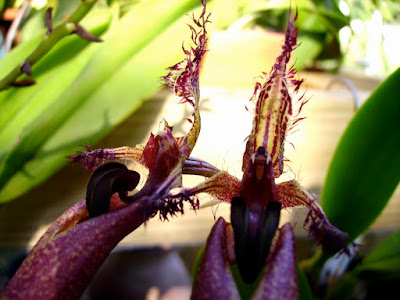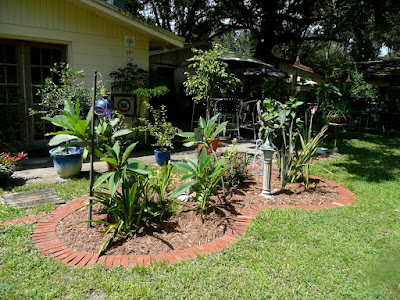Bulbophyllum 'Doris Dukes' is my new favorite orchid. I have a new favorite every month. I'm fickle that way. This orchid is named after the heiress and horticulturalist,
Doris Duke. It is blooming profusely right now, with 9 flower spikes, each with a pair of blossoms or buds. A. suggested in a comment on my last post, that the new patio table looked lonely without a plant on it. You are absolutely right! Here's Doris on the table in a beautiful peacock planter (also found at a yard sale for $.50).
Static pictures do not do Doris justice. She has fine feathery fringe that moves with the slightest breeze. A hinged lip teeters when one touches it. Makes me wonder what type of pollinator she seeks to attract. This plant is a hybrid, though. A sort of gorgeous Frankenstein created in a greenhouse and pollinated by humans. I think she looks waspish. We have seen wasps flying around the plant, looking confused.
Bulbophyllum may be pollinated by flies or wasps. There are 1,803 species in the genera, most of them originating in Papua New Guinea and Borneo. I took a little video of Doris in motion to show you how she moves (see above).
I've become fascinated by our orchids' names and the origins of those names. We brought the next one home from the
Florida State Fair last year. At the time, I just thought it was beautiful with it's blood red petals fringed with cream. Now that it's blooming again, and I want to write about it, I went out and copied the name from the tag...Colm. Chadwick "Wildcat". Colm? I looked in two orchid books I have and didn't find Colm. I did find it in
100 Orchids for the American Gardener
by Elvin McDonald. Colm. stands for Colmanara, which is a hybrid named for Sir Jeremiah Colman (1859-1942). You may have some of his
mustard in your pantry (damned good in deviled eggs). This is Colmanara Chadwick "Wildcat"...
 by Elvin McDonald. Colm. stands for Colmanara, which is a hybrid named for Sir Jeremiah Colman (1859-1942). You may have some of his mustard in your pantry (damned good in deviled eggs). This is Colmanara Chadwick "Wildcat"...
by Elvin McDonald. Colm. stands for Colmanara, which is a hybrid named for Sir Jeremiah Colman (1859-1942). You may have some of his mustard in your pantry (damned good in deviled eggs). This is Colmanara Chadwick "Wildcat"...





Comments